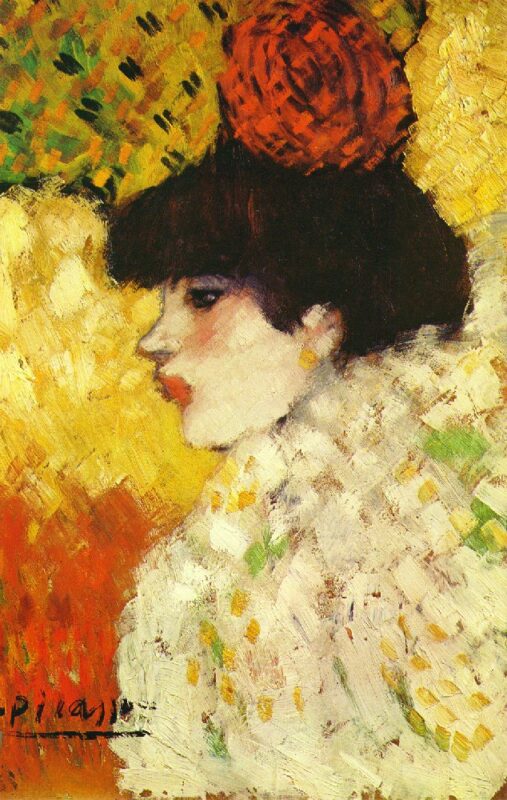Introduction: Picasso’s Early Years (1901-1909) and Artistic Evolution
Pablo Picasso is one of the most influential artists of the 20th century, and his early years from 1901 to 1909 played a crucial role in shaping modern art. This period saw the emergence of three defining artistic phases—the Blue Period (1901-1904), the Rose Period (1904-1906), and the early Cubist explorations (1907-1909).
In this online gallery, we showcase some of Picasso’s most significant works from this transformative decade. From the melancholic blues of his early paintings to the vibrant hues of his circus-inspired Rose Period and the revolutionary beginnings of Cubism, this collection captures Picasso’s journey toward artistic mastery.
Picasso’s Blue Period (1901-1904) – Melancholy in Shades of Blue
The Blue Period (1901-1904) is one of Picasso’s most famous and emotionally charged phases. Dominated by somber blue tones, these paintings reflect themes of sadness, poverty, and isolation.
Notable Blue Period Paintings:
- The Old Guitarist (1903) – A haunting image of a blind musician, symbolizing human suffering.
- La Vie (1903) – A complex composition depicting themes of life, death, and destiny.
- Woman with Folded Arms (1902) – A portrait conveying despair and introspection.
During this time, Picasso was deeply influenced by his friend Carlos Casagemas’ suicide, which is often cited as a catalyst for the introspective and melancholic nature of these works.
The Rose Period (1904-1906) – A Shift Towards Warmth and Emotion
After years of painting in melancholic blues, Picasso’s work took a dramatic turn toward warmth and vibrancy in what is now called the Rose Period (1904-1906). This era introduced warmer colors—pinks, reds, and oranges—alongside subjects inspired by circus performers, acrobats, and harlequins.
Famous Rose Period Paintings:
- Garçon à la Pipe (1905) – A delicate portrait of a young boy with a pipe, radiating a sense of nostalgia.
- Acrobat and Young Harlequin (1905) – Capturing movement and poetic solitude.
- The Family of Saltimbanques (1905) – A masterful depiction of wandering circus performers, symbolizing the artist’s own sense of detachment from society.
The Rose Period reflected a more optimistic and romantic side of Picasso’s art, marking a transition from the deep introspection of the Blue Period to a playful, lyrical approach.
Picasso’s Transition to Cubism (1907-1909) – The Birth of a New Art Form
By 1907, Picasso radically changed his artistic approach, drawing inspiration from African art, Iberian sculpture, and Post-Impressionist influences. This led to the creation of Cubism, a groundbreaking movement that deconstructed traditional perspectives in art.
Key Early Cubist Works (1907-1909):
- Les Demoiselles d’Avignon (1907) – Considered the first true Cubist painting, this work shattered conventional beauty standards with its geometric abstraction and sharp angles.
- Three Women (1908-1909) – One of Picasso’s earliest full Cubist compositions.
- Bread and Fruit Dish on a Table (1909) – A still life that highlights Picasso’s move toward fragmentation and abstraction.
These years were marked by experimentation and the foundation of modern abstraction, as Picasso and Georges Braque pioneered the Cubist movement, reshaping art history forever.
Gallery: Pablo Picasso’s Paintings from 1901-1909
This curated gallery features Picasso’s iconic works from the Blue Period, Rose Period, and early Cubism. Click on each painting to explore its history, artistic technique, and significance in Picasso’s evolution.
Conclusion: The Impact of Picasso’s Early Paintings on Modern Art
The years 1901 to 1909 represent a pivotal era in Pablo Picasso’s career. During this time, he evolved from a young, emotionally charged artist into the founder of an entirely new movement—Cubism. His works from this period not only reflect his personal struggles and artistic exploration but also laid the groundwork for modern art as we know it today.
Through this online gallery, we invite you to witness the artistic genius of Picasso’s formative years, a period that forever changed the course of art history.






















































































































































































































































































